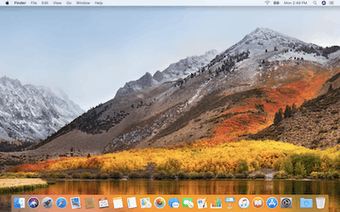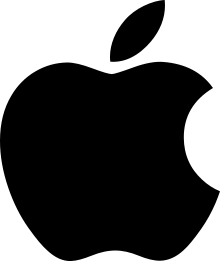macOS High Sierra
macOS High Sierra (version 10.13) is the fourteenth major release of macOS, Apple Inc.'s desktop operating system for Macintosh computers. macOS High Sierra was announced at the WWDC 2017 on June 5, 2017[2] and was released on September 25, 2017. The name "High Sierra" refers to the High Sierra region in California. Like with Snow Leopard, Mountain Lion and El Capitan, the name also alludes to its status as a refinement of its predecessor, focused on performance improvements and technical updates rather than user features. Among the apps with notable changes are Photos and Safari.[2][3][4]
| A version of the macOS operating system | |
 macOS High Sierra desktop | |
| Developer | Apple Inc. |
|---|---|
| OS family | |
| Source model | Closed, with open source components |
| Initial release | September 25, 2017 |
| Latest release | 10.13.6 Security Update 2020-004[1] (17G14019) (July 15, 2020) [±] |
| Update method | Mac App Store |
| Platforms | x86-64 |
| Kernel type | Hybrid (XNU) |
| License | APSL and Apple EULA and Non-Disclosure Agreement |
| Preceded by | macOS 10.12 Sierra |
| Succeeded by | macOS 10.14 Mojave |
| Official website | macOS High Sierra at the Wayback Machine (archived September 11, 2018) |
| Support status | |
| Extended support is likely to end in late 2020 and iTunes likely in mid-2021. | |
System requirements
macOS High Sierra runs on the following Macintosh computers:[5]
- iMac: Late 2009 or later
- MacBook: Late 2009 or later
- MacBook Pro: Mid 2010 or later
- MacBook Air: Late 2010 or later
- Mac Mini: Mid 2010 or later
- Mac Pro: Mid 2010 or later
macOS High Sierra requires at least 2 GB of RAM and 14.3 GB of available disk space.
HEVC hardware acceleration requires a Mac with a sixth-generation Intel processor or newer:
- iMac: Late 2015 27" or later, Mid 2017 21.5" or newer
- MacBook: Early 2016 or later
- MacBook Pro: Late 2016 or later
- iMac Pro
External graphics processor support requires a Thunderbolt 3-enabled Mac:
- MacBook Pro: Late 2016 or later
- iMac: Mid 2017 or later
- iMac Pro
It is possible to install High Sierra on many older Macintosh computers that are not officially supported by Apple. This requires using a patch to modify the install image.[6]
Changes
System
Apple File System
Apple File System (APFS) replaces HFS Plus as the default file system in macOS for the first time with High Sierra.[2] It supports 64‑bit inode numbers, is designed for flash memory, and is designed to speed up common tasks like duplicating a file and finding the size of a folder's contents. It also has built‑in encryption, crash‑safe protections, and simplified data backup on the go.[7]
Metal 2
Metal, Apple's low-level graphics API, has been updated to Metal 2. It includes virtual-reality and machine-learning features, as well as support for external GPUs.[2] The system's windowing system, Quartz Compositor, supports Metal 2.
Media
macOS High Sierra adds support for High Efficiency Video Coding (HEVC), with hardware acceleration where available, as well as support for High Efficiency Image File Format (HEIF). Macs with the Intel Kaby Lake processor offer hardware support for Main 10 profile 10-bit hardware decoding, those with the Intel Skylake processor support Main profile 8-bit hardware decoding, and those with AMD Radeon 400 series graphics also support full HEVC decoding.[2] However, whenever an Intel IGP is present, the frameworks will only direct requests to Intel IGP. In addition, audio codecs FLAC and Opus are also supported, but not in iTunes.[8][9]
Other
Kernel extensions ("kexts") will require explicit approval by the user before being able to run.[10]
The Low Battery notification and its icon were replaced by a flatter modern look.
The time service ntpd was replaced with timed for the time synchronisation.[11]
The FTP and telnet command line programs were removed.[12]
The screen can now be locked using the shortcut Cmd+Ctrl+Q. The ability to lock screen using a menu bar shortcut activated in Keychain Access preferences has now been removed.[13]
The 10.13.4 update added support for external graphics processors for Macs equipped with Thunderbolt 3 ports.[14] The update discontinued support for external graphics processors in 2015 or older Macs, equipped with Thunderbolt 1 and 2 ports.
Starting with 10.13.4, when a 32-bit app is opened, users get a one-time warning about its future incompatibility with the macOS operating system.[15]
Applications
Final Cut Pro 7
Apple announced the original Final Cut Studio suite of programs will not work on High Sierra. Media professionals that depend on any of those programs were advised to create a double boot drive to their computer.[16]
Photos
macOS High Sierra gives Photos an updated sidebar and new editing tools.[2] Photos synchronizes tagged People with iOS 11.[2]
Mail
Mail has improved Spotlight search with Top Hits.[2] Mail also uses 35% less storage space due to optimizations, and Mail's compose window can now be used in split-screen mode.[17]
Safari
Safari has a new "Intelligent Tracking Prevention" feature that uses machine learning to block third parties from tracking the user's actions.[18] Safari can also block autoplaying videos from playing.[19][20] The "Reader Mode" can be set to always-on.[21] Safari 11 also supports WebAssembly.[22]
Notes
The Notes app allows the user to add tables to a note.[23] A note can be pinned to the top of the list.[24]
Siri
Siri now uses a more natural and expressive voice. It also uses machine learning to understand the user better. Siri synchronizes information across iOS and Mac devices so the Siri experience is the same regardless of the product being used.[25]
Messages
The release of macOS High Sierra 10.13.5 (and iOS 11.4) introduced support for Messages in iCloud.[26] This feature allows messages to sync across all devices using the same iCloud account. When messages are deleted they are deleted on each device as well, and messages stored in the cloud do not take up local storage on the device anymore.[27] In order to use the feature, the user has to enable two-factor authentication for their Apple ID.[28]
Reception
Reception of macOS High Sierra was reportedly positive.[29]
Problems
macOS High Sierra 10.13.0 and 10.13.1 have a critical[30] vulnerability that allowed an attacker to become a root user by not entering the password. This was fixed in the Security Update 2017-001 macOS High Sierra v10.13.1.[31]
When it was first launched, it was discovered that the process named "WindowServer" had a memory leak, leading to much slower graphics performance and lagging animations, probably due to some last-minute changes in Metal 2. This was fixed in macOS 10.13.1.
macOS High Sierra 10.13.4 had an error that caused DisplayLink to stop working for external monitors. Only 1 monitor is able to be extended, if using 2 external monitors, they can only be mirrored. This also seems to be an issue with the beta version of Mojave. DisplayLink have said they are working with Apple to resolve the issues but as of the most recent macOS High Sierra update, the issue still persists.[32]
Release history
| Previous release | Current release |
References
- "About the security content of macOS Catalina 10.15.6, Security Update 2020-004 Mojave, Security Update 2020-004 High Sierra". Apple Support. July 15, 2020. Retrieved July 15, 2020.
- "Apple Events - WWDC Keynote, June 2017 - Apple". Archived from the original on 2017-06-06.
- "MacOS 10.13 High Sierra Announced, Release Date Set for Fall". OS X Daily. Archived from the original on 27 June 2017. Retrieved 6 June 2017.
- Cunningham, Andrew. "macOS High Sierra tech preview: A quick look at the stuff you can't see". Ars Technica. Archived from the original on 20 June 2017. Retrieved 20 June 2017.
- "How to download macOS High Sierra". Apple Inc.
- macOS High Sierra Patcher Tool for Unsupported Macs
- "Apple File System (APFS) announced for 2017, scales 'from Apple Watch to Mac Pro' and focuses on encryption". 9to5Mac. 2016-06-13. Archived from the original on 2017-03-28. Retrieved 2017-09-12.
- "iOS 11、macOS High Sierra:FLAC、Opus、HOA(3Dサウンド)をサポート" [iOS 11, macOS High Sierra: Supports FLAC, Opus, HOA (3D sound)]. Macお宝鑑定団 blog(羅針盤) (in Japanese). Archived from the original on 2017-09-14.
- What's New in Audio - WWDC 2017 - Videos - Apple Developer. Archived from the original on 2017-09-14.
- "Secure Kernel Extension Loading". Apple Developer. June 19, 2017. Retrieved June 24, 2017.
- "Has anyone got the time? How High Sierra has changed time synchronisation".
- "How to get BSD FTP and Telnet back in 10.13 (High Sierra)?". Ask Different.
- "New Lock Screen feature in macOS High Sierra". July 17, 2017.
- "Use an external graphics processor with your Mac". Apple.
- "32-bit app compatibility with macOS High Sierra 10.13.4 - Apple Support". April 11, 2018.
- https://larryjordan.com/articles/important-caution-about-apples-high-sierra/
- "macOS High Sierra: Everything We Know | MacRumors". Archived from the original on 2017-06-17. Retrieved 2017-09-11.
- Lomas, Natasha. "Apple adds ad tracker blocker to desktop Safari | TechCrunch". Archived from the original on 2017-06-07. Retrieved 2017-06-07.
- O'Kane, Sean (2017-06-05). "Apple's new version of macOS is called High Sierra". The Verge. Archived from the original on 2017-06-07. Retrieved 2017-06-08.
- "macOS is now fully baked with macOS High Sierra". Ars Technica. Archived from the original on 2017-06-07. Retrieved 2017-06-08.
- "5 Notable New Features Coming to macOS High Sierra". OS X Daily. 2017-06-09. Archived from the original on 2017-06-27. Retrieved 2017-06-10.
- "What's New in Safari". Archived from the original on 2017-11-14.
- "Apple Reveals 'macOS High Sierra' With APFS, Metal 2, and Refinements to Safari and Other Apps". Archived from the original on 2017-06-06. Retrieved 2017-06-10.
- Gil, Lory (8 June 2017). "macOS High Sierra FAQ: Everything you need to know!". iMore. Archived from the original on 19 June 2017. Retrieved 20 June 2017.
- "macOS High Sierra: Everything We Know | MacRumors". Archived from the original on 2017-06-17. Retrieved 2017-09-11.
- "Apple Releases macOS High Sierra 10.13.5 With Messages in iCloud Support". MacRumors. 2018-06-01. Retrieved 2018-11-01.
- "iOS 11.4: What you need to know about Messages in iCloud". CNET. 2018-05-29. Retrieved 2018-11-01.
- "How to sync your text messages to iCloud". iMore. 2018-06-01. Retrieved 2018-11-01.
- "macOS High Sierra review: Incremental update worthy of your time, eventually". Macworld. 2017-09-25. Retrieved 2018-11-01.
- "Vulnerability Details : CVE-2017-13872".
- "macOS High Sierra 'root' security bug: Here's how to fix it now!". iMore. Archived from the original on 2017-12-04. Retrieved 2017-12-06.
- "macOS High Sierra 10.13.4+ and Mojave 10.14 Early Previews". DisplayLink Support.
External links
- Official website at the Wayback Machine (archived September 11, 2018)
| Preceded by macOS 10.12 (Sierra) |
macOS 10.13 (High Sierra) 2017 |
Succeeded by macOS 10.14 (Mojave) |
